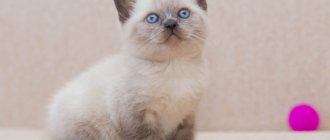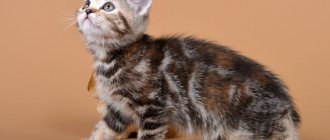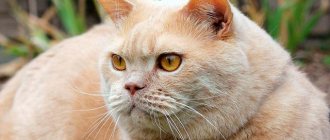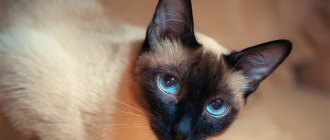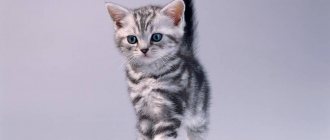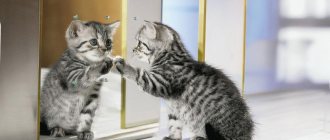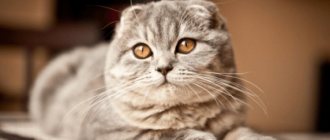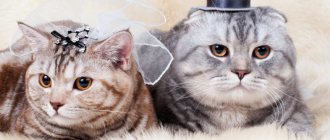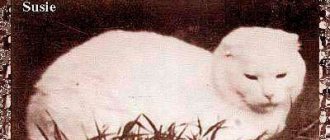Scottish cats have different colors. Scottish cats are famous because of their charming appearance and variety of colors. The color of kittens directly depends on certain genes. As a rule, these are two main shades, black and white.
Scottish Straight colors, for example, are gray with black stripes around the entire body. They are distributed as a percentage. That is, the animal’s fur is painted in two colors in different proportions. Its own gene is responsible for the dominance of one color or another.
Plain (solid)
The color of Scottish Fold cats is monochromatic and they should not have any other color. The fold-eared cat can be of the following colors: white and black, chocolate and lilac, blue and red, cream, fawn and cinnamon. The most popular color in the world among solid Scottish cats is blue. These are the majority of cats.
White
The white Scottish Straight cat can have different eyes, from blue and bright orange to rich amber and copper. Kittens of this variety remain white for the rest of their lives. If kittens have spots, then an adult cat remains white for the rest of its life.
Black
The Scottish Fold black cat is mostly bright in color. A couple of white hairs are acceptable, but if the cat has large red and brown patches, then it is not a purebred.
Black Scottish Fold cats should be bright black in color and their ears, like all fold-eared cats, should be pressed to the head, unlike straight-eared cats. A straight-eared black cat always has its ears erect.
Chocolate
The chocolate Scottish Fold looks impressive. The chocolate color is quite rare. Brown fold kittens should have a smooth, uniform coat of chocolate color. The dark brown coloring adds nobility to the cat.
A brown cat gets this color if he has chocolate, chocolate bicolor or chocolate color points in his pedigree. Chocolate Scottish kittens always delight their owners. They look very cool against a light background.
Lilac (lavender)
A lilac long-eared cat gets this color if he has either lilac color points or lilac in his pedigree. The lilac coloration goes well with orange, copper or amber colored eyes and a light brown nose. This color is also called coffee with milk.
Blue color (blue)
The Scots Blue can have a coat color of many shades of blue. Some cats may have a fur color closer to gray, and some closer to blue. Each hair must be saturated, then the coat will be perfectly blue.
Scottish Fold color codes
The concept of color is represented by the color of the cat's fur, the pattern of stripes or its complete absence, the presence or absence of white spots on the fur . Also degrees of coloration. The basic colors are red and black.
This is interesting! Currently, for the purpose of unification, an absolutely clear coding system has been developed, which is used by FIFе and WСF specialists.
This system is very convenient, and includes not only alphabetic, but also digital designations:
- a - bluе or light blue color;
- b - chocolate, brown and chestnut or chocolate, brown coloring, as well as Havana and champagne;
- c - lilac, lavender or lilac and lavender, as well as platinum color;
- d - red, flame or red color;
- e - cream or cream color;
- f - tortoiseshell and patch or tortoiseshell color;
- g - blue-cream and blue-tortie or bluish-cream, bluish-tortoiseshell color;
- h - chocolate-tortie or chocolate tortoiseshell color;
- j - lilac-toortie or lilac-tortoiseshell color;
- n - black, ebony, seal, sable and ruddy or black, ebony and seal colors, as well as sable and wild colors;
- o - sorrel, cinnamon and honey or sorrel and cinnamon, as well as honey color;
- p - beige fawn or yellow-brown and beige color;
- q - sorrel tortie or red-brown, tortoiseshell color;
- r - beige fawn tortie or beige tortoiseshell color;
- s - silver and smoke or silver and smoky color;
- w - white or white color;
- x - unregistered or color of an unregistered type;
- y - golden or golden color.
Registered digital designation of the coat color of the Scottish Fold breed:
- 01 - van or “van”;
- 02 - harlequin or “harlequin”;
- 03 - bicolour or “two-color”, “bicolor”;
- 04 - mitted/white point or color point with white markings;
- 09 - little white spots or with white spots measuring 1-2 cm;
- 11 - shaded or with the upper part of the coat darkened by a quarter;
- 12 - tippred, shell or with darkening of the upper part of the coat 1/8 from the tip;
- 21 - tabby, agouti or with stripes, “agouti factor”;
- 22 - blotched, marble or “marble”;
- 23 - mackerel, tiger or “mackerel” and “tiger”;
- 24 - spotted or “spotted”
- 25 – ticked or ticked “Abyssinian”.
Thanks to convenient classification and coding, it is possible to select an animal with the most incredible coat color.
Return to content
Bicolors
The coat color of these beautiful creatures has two colors, and a combination of white and any other shade is mandatory. Purebred bicolors must have a white belly, neck, chest, chin, limbs and, of course, muzzle.
Particolor (calico)
A Scottish cat of this type, called particolor, is a combination of white with tortoiseshell or spotted tabby color.
Harlequin
Harlequin captivated everyone with his unusual appearance. The cat is painted white (4/5 parts of the body), but the tail must be black, as well as the ears and the top of the head. The ventral part is white. The tip of the nose, like most people, is the same color – pink.
Wang
This breed only has colored tail, and sometimes has a few spots on the head. It happens that there are solid spots on the paws and back, but this is considered undesirable. When this breed develops red spots, it may also be called a Red Van.
Character and health of the breed
Their gentle and friendly nature makes them good companions. A cat will always wait for its owner. To lie quietly next to him while he goes about his business or to play with him.
Fold cats are smart and quick-witted, they love different toys and puzzles. It is unlikely that they will lie quietly all day alone. They will need company for entertainment. Therefore, the Scots are not the best choice for those people who disappear all day at work.
The favorite pastime of the breed is interaction with humans. This can be an exciting game or simple stroking, but always together. They are sweet and love attention to themselves, seeking it by any means.
They often have genetic diseases. Disorders of the musculoskeletal system are possible, in particular, degenerative changes in the joints in the tail area. This leads to decreased activity and loss of mobility. The heart is also weak. Cases of hypertrophic cardiomyopathy are common.
Color point
The Color Point is a rare breed of Scottish cat with a color similar to that of a Siamese cat. In childhood they look a little like Thai kittens. The main background is white or cream. The muzzle, ears, paws and tail are painted in darker shades. Color point or links point have blue eyes.
They acquired their colors from their British ancestors, who had Persians with this shade in their family. By the way, it is very difficult to distinguish a British cat from a Scottish one, and even professionals cannot always do this.
History of the breed
The first mention of the breed dates back to the end of the 19th century.
It is known that an English sailor took a cat with floppy ears from the Middle Kingdom to Europe. According to some versions, it was this feline who first gave birth to a litter with a genetic change called “fold,” which translates as “bend.”
However, the official date of birth of the new breed is considered to be 1961. The white cat Susie was born on a farm in Scotland.
A few years later she gave birth to her first litter with ears curled up towards the head. One kitten from the litter was donated to an English couple who began to seriously develop a new breed.
Over time, they found out that when two parents of the Fold breed are crossed, genetically sick babies are born who have pathologies of the spine. The ears of the first representatives of the breed were not bent forward, like those of modern Scots, but slightly to the sides.
Soon a breeding ban was introduced in the UK, but it was already too late. They learned about the breed overseas and also started breeding.
In the USA, Scots were actively bred, producing healthy and beautiful cats. The breed was officially registered in America in 1976, by the authoritative organization CFA. But it became widespread only 12 years later.
At this time, European breeders again began to cultivate lop-eared animals. To obtain the best representatives of the breed, they crossed them with British and shorthair cats from Europe. American Folds were not very favored at this time, and were rarely allowed into breeding.
The Europeans managed to breed cats that closely resembled the British ones. Today there are two subgroups of Scots:
These unusual cats appeared in our country in the 90s of the 20th century. Own representatives of the breed hatched after 2-3 years. Later they were put into breeding by breeders.
Tabby (tabby)
Tabby is one of the most popular cats among Scots. The color of Scottish tabby cats is distinguished by the presence of a pattern in a certain area on the coat. The pattern on the wool can be anything. A distinctive feature is considered to be a pattern in the form of the letter M on the forehead.
Tabby color depending on the type of pattern:
- striped like a tiger (has vertical stripes on the sides);
- spotted;
- marble (pattern of chaotic spots and stripes of different sizes).
And depending on the color combinations to the following:
- golden tabbies;
- cream tabby;
- blue;
- black marble;
- marble on silver
- silvery blue (gray tint);
- silver (silver color);
- cameo.
Breed standard
The description of the representatives of the breed as they should be according to all accepted standards is based on documents issued in the USA and Europe by the authoritative organizations CFA, TICA and WCF.
The body of the animal is medium, strong, with rounded shapes, the main thing is its proportionality and the length of the limbs, which end with powerful paws.
The head also has a rounded shape, on which huge round eyes stand out clearly. It sits on a short neck and appears smooth due to the ears being laid back.
The standards of the American organization dictate full mobility of the animal's tail.
In Europe, cats are assessed less biasedly based on the condition of their fur than in America.
In the USA there are standards for long-haired and short-haired representatives of the breed. For example, American documents indicate that the color and structure of an animal’s coat depends not only on genetic characteristics, but also on climate, nutrition, living conditions and other factors.
The CFA does not recognize lilac, chocolate or point colors.
There are also clear indications of defects that are unacceptable for Scottish folds:
If there are deficiencies, the cat does not have the right to be called a show class representative. Participation in exhibition events is closed to her.
White based colors
These colors of Scottish breeds are:
- Bicolor. Two-color ones, in turn, are presented with the addition of the following colors to white: blue, black, cream, red. The muzzle, abdomen, limbs and thighs remain entirely light. The eyes are the color of gold or sky. Such tartans can have eyes of different colors.
- Wang. Almost all the fur is white, only the tail and a couple of markings on the head are colored.
- Harlequin. The edge is mostly white, only a fifth of the surface is colored.
- Ticking. All fur with distinct ticking. The eyes are all shades of gold; those with a silver color are greenish.
Tortoiseshell color
The main background is black and the pattern is clear fire and peach markings. Copper colored eyes. The nose and pads are either pink or black.
Scottish cats have different colors. Scottish cats are famous because of their charming appearance and variety of colors. The color of kittens directly depends on certain genes. As a rule, these are two main shades, black and white.
Scottish Straight colors
, for example, gray with black stripes around the entire body. They are distributed as a percentage. That is, the animal’s fur is painted in two colors in different proportions. Its own gene is responsible for the dominance of one color or another.
Chinchilla tartan colors
It comes in the following varieties:
- Silver. The undercoat is white, the hairs seem to be covered with gray hair. There may be a hint of stripes on the tail. The tips of the ears, belly and chin are white. The eyes are green, the nose is beige. The eyes, nose and lips are framed in black, and the pads are the same color.
- Red, aka Shell Cameo. The undercoat is snow-white, almost all the fur is covered with a red coating, only the chin, the ends of the ears and the belly are pure white. The eyes are golden, the tip of the nose is brick, and the pads are pinkish.
Shaded colors
The undercoat is almost white, the ends of the hairs are whitish. Almost the entire edge is covered with one color or another, only the chin and abdomen are completely light.
Shaded can be:
- Golden. The undercoat is light peach, the fur has a golden glow. The eyes are green, the paw pads and nose are dark chocolate.
- Silver. The undercoat is snow-white, the tips of the hairs are dark gray. The eyes are greenish, edged with black. The last feature is characteristic only of the silver variety; other Scottish shaded colors do not have eyeliner. The nose mirror is brick-colored. Black edging of mouth and nose, pads.
- Red, aka Cameo. This variety of shaded color has a snow-white undercoat, and there is a dark red coating on the coat. Only the muzzle and chin, the abdomen and the underside of the tail remain completely light. The eyes are like amber. The nose, eyeliner and pads are pinkish.
